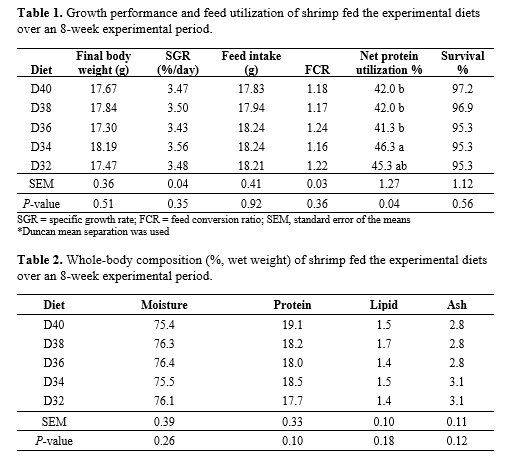RESPONSE OF WHITELEG SHRIMP TO DIETARY PROTEIN LEVELS BALANCED FOR AMINO ACIDS USING SUPPLEMENTAL SOURCES
Introduction
Cost of shrimp feed is largely dictated by dietary protein levels and sources. Commercial shrimp feed typically contains 35-40% crude protein (CP), depending on feed type. Shrimp, like other farm animals, don’t have a true requirement for protein, but for a well-balanced dietary amino acid level. In the commercial feeds, the bulk of shrimp requirements for essential amino acids (EAA) are met through intact sources. Following ideal protein concept in formulating shrimp diets for EAA requirements using supplemental sources is slowly gaining momentum in shrimp feeds due to its potential to spare the dietary protein sources such as fish meal and thus, the dietary protein content and feed cost . The objective of this study was to evaluate the performance of whiteleg shrimp to varying levels of dietary protein balanced for amino acid profile using supplemental amino acids.
Material and methods
A positive control diet containing high dietary protein level (40%), mimicking the industry standard diet with 14% fish meal level, was formulated (D40). A set of treatment diets containing 38% (D38), 36% (D36), 34% (D34) and 32% (D32) crude protein levels was formulated by reducing the inclusion of intact protein sources such as fish meal and wheat gluten meal , while meeting our recommended amino acid levels using supplemental sources including AQUAVI® Met-Met, L-Lys and L-Thr. With this approach, the formulation cost of feed was gradually reduced with the increasing protein reduction, up to 20% between D40 and D32. All the diets were produced by a commercial feed mill in Vietnam. Analyzed crude protein and amino acid levels were close to the planned values for t he diets. Four tanks (800 L water volume) were randomly allotted to each dietary treatment. Each tank was stocked with 80 shrimp (2.5 ± 0.04 g, mean ± SD) . A water temperature of ~30 °C and a salinity of ~15 ppt were maintained throughout the experiment. Shrimp were fed with the respective diets to apparent satiation, 4 times daily over 56 days. Mortality was daily recorded and accounted for survival. All the shrimp were bulk weighed at the beginning and end of the experiment, and the mean weight was calculated based on the counts of shrimp. At the end, four shrimp per tank were pooled and used for body composition analysis. From the initial population, 20 shrimp were pooled and used for initial body composition.
Results and Discussion
After 56 days, survival varied from 95% to 97% with no significant differences detected among treatments. Final body weight, growth rate, feed intake, and FCR did not differ among dietary treatments (Table 1). N et protein utilization (protein gain x 100 / protein intake) showed significant improvement in shrimp fed with the diet containing 34%CP versus those fed with the diets containing 36-40% CP, showing the benefits of feeding shrimp with the amino acid balanced reduced protein diets. Diets did not affect body composition of shrimp (Table 2). We also exam ined intestinal morphology (n = 3 shrimp per tank) of shrimp. Villus height, villus width (D40 > others), crypt depth (D36> others) and the ratio of villus height to crypt depth (D36>D38) showed significant differences, with no clear trend to the dietary CP levels. Our study results overall demonstrate the opportunity to reduce dietary protein levels in commercial shrimp feed using supplemental amino acids.
